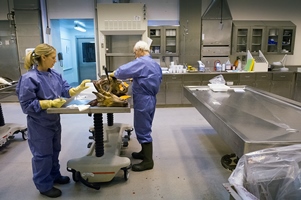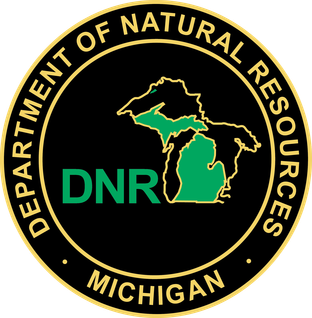Wildlife officials ask for hunters’ help in eliminating chronic wasting disease in Michigan
The 2015 Michigan deer season is the first being conducted following a finding of chronic wasting disease in a free-ranging deer in Michigan. The disease was first detected in an Ingham County white-tailed deer this past spring.
Wildlife officials are optimistic, however, that CWD can be eliminated in Michigan and are asking for hunters’ assistance.
So far, public response has been “overwhelmingly positive,” said Chad Stewart, the Department of Natural Resources deer and elk specialist.
“Most people right now are on board with what we are doing,” he said. “They seem to understand the regulatory changes we’ve made. Not everyone likes them, but they understand them.”
In April, Meridian Township police dispatched a 6-year-old female deer that was exhibiting signs of  neurological disease. An initial screening at the Department of Natural Resources Wildlife Disease Laboratory identified the deer as a CWD suspect. Soon, the National Veterinary Laboratory in Ames, Iowa, confirmed the DNR’s suspicion: Michigan became the latest state to have found CWD in its free-ranging deer herd.
neurological disease. An initial screening at the Department of Natural Resources Wildlife Disease Laboratory identified the deer as a CWD suspect. Soon, the National Veterinary Laboratory in Ames, Iowa, confirmed the DNR’s suspicion: Michigan became the latest state to have found CWD in its free-ranging deer herd.
CWD is a type of transmissible spongiform encephalopathy (TSE). The disease is an always fatal affliction for cervids – deer, elk and moose – that attacks the brain, causing lesions, which leads to emaciation, loss of fear of humans, loss of body control, drooling and, ultimately, death. It is not caused by bacteria or virus but by prions, which are mutated proteins. It is spread by animal-to-animal contact with saliva, urine, feces, blood or infected soil. There is no treatment for CWD in deer. The ailment has never been shown to cause illness in humans. For more than two decades, CWD has been present in free-ranging populations of mule deer and elk in Colorado. During this time, there has been no known occurrence of a human contracting any disease from eating CWD-infected meat.
Because of the occurrence of CWD in other states, the Michigan DNR has been vigilant about testing for the disease. Since 1998, tens of thousands of free-ranging deer have been tested in the state. The Meridian Township deer marked the second time CWD was identified in Michigan. In 2008, a single deer was found to be CWD-positive in a captive cervid facility in Kent County.
With the most recent finding, the DNR immediately instituted a policy that called for reducing deer numbers in the area of the infected deer and testing all deer – those taken by federal animal damage control officials as well as road kills – from the area for CWD.
In July, a 2-year-old buck found less than a mile from the initial CWD-positive female tested positive. In August, a 5-year-old CWD-positive female was found in close proximity to the other two. Genetic testing showed all three positives were related. Finding deer with CWD within the same extended family is not uncommon.
Wildlife officials are encouraged that so few additional CWD-infected animals have been found and that those found were closely related.
“When we found the first one, we didn’t know what we would find,” Stewart said. “Given that that deer was symptomatic – it obviously had the disease for some time – we expected to find additional animals. It’s encouraging that the ones we’re picking up are from the same family group and relatively close to where we found her. But we still have a long road ahead of us.”
Last week, a suspect positive deer was found in DeWitt Township, which is still pending final testing.
Prior to deer season, the DNR established a CWD Management Zone – consisting of Ingham, Clinton and Shiawassee counties – as well as a nine-township Core CWD Area (also known as Deer Management Unit 333). The nine townships – Lansing, Meridian, Williamstown, Delhi, Alaiedon and Wheatfield in Ingham County; DeWitt and Bath in Clinton County; and Woodhull in Shiawassee County – have stringent regulations relating to possession of deer.
It is illegal to salvage a deer killed by a motor vehicle, and no rehabilitation of deer will be allowed within  DMU 333. Hunters who shoot deer in the core area are required to bring the entire carcass to one of three DNR check stations within 72 hours. The DNR will retain the head for testing; if it’s a trophy-caliber animal, the DNR will work with the hunter to make sure the trophy is not marred but the necessary tissue is made available for testing.
DMU 333. Hunters who shoot deer in the core area are required to bring the entire carcass to one of three DNR check stations within 72 hours. The DNR will retain the head for testing; if it’s a trophy-caliber animal, the DNR will work with the hunter to make sure the trophy is not marred but the necessary tissue is made available for testing.
Once the deer has been checked, it may be processed. All leftover parts should be disposed of in the garbage, a landfill, or the dumpster provided by the DNR at check stations.
Negative test results will be posted online at www.michigan.gov/dnrlab within a week after the head has been submitted for testing. Hunters with deer that test positive will be notified by telephone. And although human health effects have not been documented for people eating CWD-infected deer, the DNR recommends that only healthy animals be consumed.
Hunters are reminded that there is no baiting or feeding of deer allowed in the three-county CWD Management Zone. Nose-to-nose contact of deer can spread the disease. Hunters who travel out of state to hunt deer, elk or moose are reminded that there are restrictions on bringing carcasses back from states or provinces where CWD has been found. Only deboned meat, antlers, hides and skull caps that have been cleaned of all brain or muscle material may be brought into Michigan.
Any hunter who has been notified by out-of-state authorities that a deer, elk or moose they brought into Michigan tested positive for CWD must contact the DNR’s Wildlife Disease Lab within two business days and provide details. The DNR can dispose of any meat from a CWD-infected animal.
Extensive testing of deer from the CWD-infected area is ongoing. As of Nov. 13, of the 1,403 deer tested in DMU 333 – and another 337 in the three-county area – only three have been determined to have chronic wasting disease, with a fourth suspect positive waiting final testing.
All 141 tested from other counties have been negative. Hunters who harvest deer outside DMU 333 and are concerned about CWD may submit their deer for testing at any DNR check station. (A list of check stations is available at www.michigan.gov/deer).
For more information on CWD in Michigan, visit www.michigan.gov/cwd.




